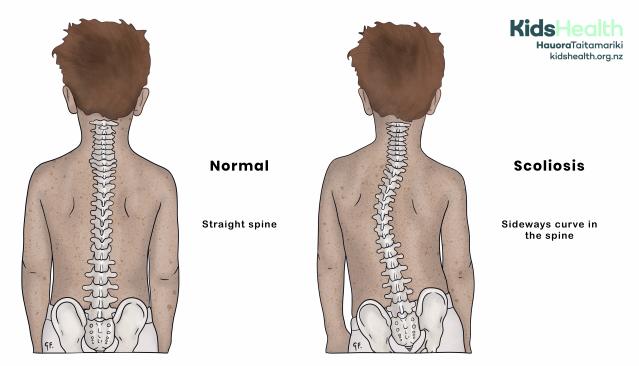Key points about scoliosis in children
- scoliosis is when the spine curves sideways
- it often starts during growth spurts, usually between ages 10 and 15
- most cases of scoliosis in tamariki are mild and don’t need treatment
- picking up scoliosis early helps prevent the curve from getting worse
- treatment can include monitoring, bracing, physiotherapy or surgery
What is scoliosis?
Scoliosis is a condition where the spine curves to the side. The spine may have an ‘S’ or ‘C’ shape. This curve can make the spine twist or rotate. It usually affects the upper or middle back but can involve the whole spine.
Scoliosis can happen as tamariki grow, especially during puberty. Most cases are mild and don’t cause problems.

Causes of scoliosis
Scoliosis can happen for different reasons.
Idiopathic scoliosis
Idiopathic scoliosis is the most common type of scoliosis in tamariki and rangatahi (young people). The cause of idiopathic scoliosis is unknown. It often starts during puberty.
Congenital scoliosis
Congenital scoliosis is when scoliosis is present at birth. It happens when the spine bones (vertebrae) don’t develop properly before birth.
Neuromuscular scoliosis
Neuromuscular scoliosis is caused by other conditions that affect the muscles and nerves. This includes conditions like cerebral palsy or muscular dystrophy.
Signs and symptoms of scoliosis
Tamariki with scoliosis may have the following:
- uneven shoulders
- one shoulder blade sticks out more
- one hip is higher than the other
- an uneven waistline
- a tilted head
- one side of the back is higher when leaning forward

Many tamariki with scoliosis don’t feel any pain and often don’t even know their spine is curved.
Diagnosing scoliosis
If you think your child may have scoliosis, take them to a health professional. Picking up and treating scoliosis early can help stop it from getting worse.
The health professional will examine your child and arrange an x-ray of their spine. They may refer your child to an orthopaedic surgeon (a doctor who specialises in bones and joints).
Managing scoliosis
Treatment for scoliosis depends on a child’s age and how much curve they have in their spine.
Mild
Tamariki with mild scoliosis may not need any treatment. They will need regular x-rays as they grow, to monitor their spine. Physiotherapy may be helpful for some tamariki with scoliosis. Physiotherapy can help to strengthen the back muscles.
Moderate
Tamariki with moderate scoliosis may need a back brace. If your child needs a brace, they will need to wear it for 23 hours a day. It fits underneath their clothes. The brace won’t fix the curve, but it may help stop it from getting worse as your child grows.
Severe
Tamariki with severe curves in their spine may need surgery. Surgery can help straighten the spine.
Managing your child with scoliosis at home
Encourage exercise
Exercise and activity are normally safe and encouraged for tamariki with scoliosis. Talk to your health professional if you have concerns about what your child can or can’t do. Encourage your child to keep active.
Brace
If your child has a brace for their scoliosis, they will need to wear this for 23 hours a day. They can take it off for an hour a day when exercising or washing. The brace fits under their clothes. Your child may need reminders to make sure they are wearing this as instructed by your health professional.
What to expect long term
Most tamariki with scoliosis live normal, active lives. Most mild cases don’t need treatment.
Scoliosis that is present before the adolescent growth spurt is more likely to progress. If treatment is needed, most tamariki do very well with a brace or surgery. Your child can still take part in school, sports, and other activities. After surgery, tamariki can usually return to school within a few weeks and get back to their normal activities over time.
Preventing scoliosis
There is no known way to prevent scoliosis. It’s not caused by anything your child did or didn’t do. Scoliosis is not caused by poor posture, carrying heavy things or sports.
Acknowledgements
Illustrations by Dr Greta File. Property of KidsHealth.
